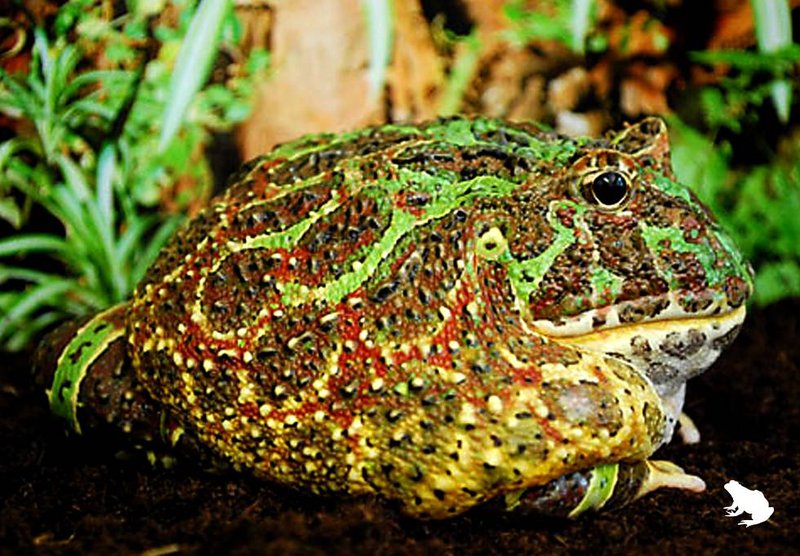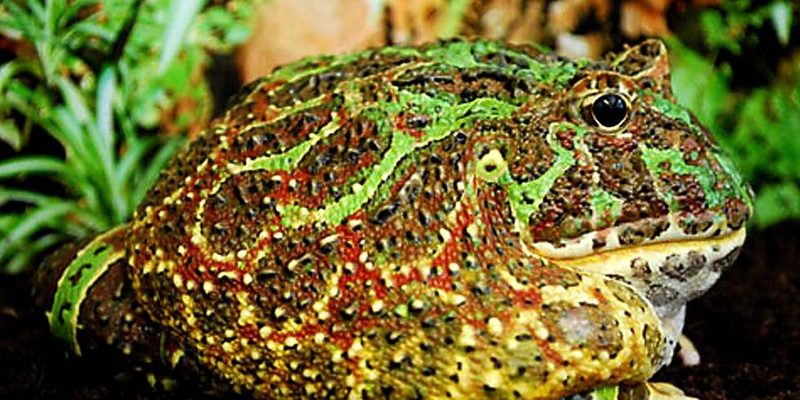
If you’re fascinated by unique wildlife, the Argentine Horned Frog might just capture your interest like no other. This remarkable amphibian, also known as the Pac-Man frog due to its round shape and voracious appetite, hails from the lush landscapes of South America. Imagine a small, plump creature that seems to have popped out of a colorful video game! With its striking appearance and peculiar behaviors, it’s no wonder that many people are drawn to learning more about it.
But the Argentine Horned Frog is more than just its playful nickname. It’s a creature that thrives in a diverse range of habitats and has unique adaptations that help it survive in the wild. In this article, we’ll dive deep into the life of this captivating amphibian, exploring everything from its physical characteristics to its diet and conservation status. So, grab your coffee and let’s jump into the world of the Argentine Horned Frog!
Physical Characteristics
The Argentine Horned Frog is hard to miss, thanks to its distinctive physical traits. They typically exhibit a robust and rounded body, often growing to about 4 to 6 inches in length. With their broad heads and powerful jaws, they boast a unique appearance that resembles an exaggerated caricature of a frog. You might notice their vibrant colors, which range from olive green to brown, often with patterns that help them blend into their surroundings. This camouflage is essential for both hunting and evading predators.
Another notable feature is the horn-like projections above their eyes. These are not actual horns, but they give the Argentine Horned Frog a striking profile. They serve to enhance its appearance, making it look more intimidating to potential threats. These frogs also have skin that can vary in texture, with some being smooth and others rough, adding to their overall unique look. All these traits come together to create a creature that stands out in the animal kingdom.
In terms of behavior, Argentine Horned Frogs are mostly nocturnal, meaning they come alive during the night. This is when they hunt and forage for food. Their wide mouths allow them to devour prey that is surprisingly large for their size, including insects, small rodents, and even other frogs. This unique predatory behavior makes them efficient hunters in their natural habitat.
Habitat and Distribution
The Argentine Horned Frog can be found primarily in the wet regions of South America, particularly in Argentina, Paraguay, and parts of Brazil. These frogs prefer habitats such as moist grasslands, forests, and even agricultural areas where water is readily available. Their love for water means you’ll often find them in or near ponds and swamps, where they can easily hunt and hide from predators.
The tropical climate of their native environment plays a significant role in their lifestyle. Humidity and warmth are essential for their survival, allowing them to thrive. They are known to bury themselves in the mud during dry seasons, which helps them conserve moisture and avoid desiccation. This unique adaptation showcases their ability to survive in fluctuating environmental conditions.
While the Argentine Horned Frog might be widespread in its native regions, habitat destruction poses a significant threat to its population. As forests are cleared for agriculture or urban development, these frogs lose their natural homes. Conservation efforts are crucial to ensure that they continue to thrive in the wild.
Diet and Feeding Habits
The diet of the Argentine Horned Frog is as fascinating as its appearance. These frogs are carnivorous and have an insatiable appetite. They primarily feed on insects, including crickets and beetles, as well as small mammals such as mice. The sheer size of their mouths allows them to consume prey that is often larger than their own heads. Imagine this frog as a tiny predator, ready to ambush its next meal with lightning speed!
Feeding is often a display of patience. Argentine Horned Frogs are ambush hunters, remaining still and waiting for prey to come close. When an unsuspecting insect wanders near, the frog uses its powerful tongue to snatch it up with incredible speed. This hunting technique is not just fascinating to watch; it’s highly effective, ensuring they can capture enough food to sustain themselves.
It’s interesting to note that when kept in captivity, these frogs may require a varied diet of live food to simulate their natural foraging behavior. This is essential for their health and well-being. If you’re thinking of keeping one as a pet, be prepared to provide a diet rich in protein to keep your little amphibian happy and healthy!
Reproduction and Lifespan
The reproductive habits of the Argentine Horned Frog are quite intriguing. Breeding typically occurs during the rainy season, which provides the moist environments these frogs need for laying eggs. Females can produce a large number of eggs—a single clutch can contain over a thousand eggs! These eggs are usually laid in shallow pools, where they hatch into tadpoles.
The tadpoles of the Argentine Horned Frog grow quickly, feeding on algae and plant matter before metamorphosing into adult frogs. This transformation is a critical phase of their life cycle, as they transition from an aquatic to a terrestrial existence. It’s a remarkable journey that highlights the adaptability of these creatures.
Conservation Status
The conservation status of the Argentine Horned Frog is a topic of growing concern among wildlife enthusiasts. While these frogs are not currently classified as endangered, their populations are affected by habitat loss due to agricultural expansion and urban development. This destruction of their natural habitats poses a significant risk and threatens their survival in the wild.
Efforts to preserve the Argentine Horned Frog include habitat protection and raising awareness about the importance of conserving wetlands. Conservation groups are working tirelessly to create initiatives that promote sustainable land use and protect the natural environments these frogs rely on. By raising awareness, people can better understand the value of preserving such unique species.
Interesting Facts
Throughout our exploration of the Argentine Horned Frog, you might be surprised to learn some quirky details about this amphibian. For starters, their loud croaks can be heard during the breeding season, where males call to attract females. It’s a sound that buzzes through their natural habitat, signaling the start of the mating ritual.
In addition to their impressive hunting skills, Argentine Horned Frogs are also known for their ability to change colors. While this change isn’t as dramatic as that of a chameleon, they can darken or lighten their skin tone to blend in with their surroundings better. This adaptability enhances their survival chances in the wild.
Lastly, in some cultures, these frogs are part of folklore and are even considered symbols of fertility due to their high reproductive rates. Interestingly enough, they have also gained popularity in the pet trade, captivating amphibian enthusiasts with their unique appearance and engaging behaviors.
Care in Captivity
If you’re considering bringing an Argentine Horned Frog into your home, acknowledging their unique care requirements is essential. These frogs thrive in warm, humid environments, so a well-maintained terrarium with proper heating and humidity control is crucial. A temperature range of about 75°F to 85°F is ideal for their comfort.
Moreover, providing adequate substrate for burrowing is important. Many owners opt for coconut fiber or a mixture of soil and sand, as it allows the frog to dig and feel secure. Don’t forget to include shallow water dishes for hydration, as these creatures enjoy soaking occasionally to maintain their moisture levels.
Feeding your Argentine Horned Frog requires a bit of dedication. They should be offered a diet rich in live foods, such as crickets, mealworms, and other insects. It’s essential to dust the food with vitamins and minerals to ensure a well-rounded diet. And remember, these little guys have hefty appetites—make sure to feed them appropriately for their size and age!
FAQ
What is the Argentine Horned Frog’s primary diet?
The Argentine Horned Frog primarily feeds on a variety of insects, but it’s not picky! These frogs are known to capture small mammals like mice and even other frogs. Their broad mouths and powerful jaws enable them to eat prey that may be larger than their heads.
Where can I find Argentine Horned Frogs in the wild?
You can find Argentine Horned Frogs in the wet regions of South America, particularly in countries like Argentina, Paraguay, and Brazil. They thrive in moist habitats like grasslands and forests, with a preference for areas close to water sources.
How do Argentine Horned Frogs reproduce?
Reproduction occurs during the rainy season when females lay a large number of eggs in shallow pools. The eggs hatch into tadpoles that eventually metamorphose into adult frogs, moving from an aquatic to a terrestrial existence.
What is the lifespan of an Argentine Horned Frog?
In the wild, Argentine Horned Frogs typically live around 5 to 10 years. However, with proper care, they can live even longer in captivity, depending on environmental conditions and diet.
What are some unique features of Argentine Horned Frogs?
One unique feature is their horn-like projections above their eyes, which enhance their appearance and serve to intimidate predators. Additionally, these frogs can change their skin color slightly to blend in with their surroundings.
Are Argentine Horned Frogs endangered?
Currently, the Argentine Horned Frog is not classified as endangered. However, habitat loss threatens their populations, prompting calls for conservation efforts to protect their natural environments.
Can Argentine Horned Frogs be kept as pets?
Yes, Argentine Horned Frogs can be kept as pets, but they require specific care conditions such as a warm, humid environment, appropriate substrate for burrowing, and a balanced diet of live food. If you’re considering one, be prepared for their unique needs!
What do Argentine Horned Frogs sound like?
During the breeding season, male Argentine Horned Frogs produce loud croaks to attract females. These vocalizations can carry across their natural habitats, creating a symphony of sounds that signal their readiness to mate.
Do Argentine Horned Frogs have any predators?
Yes, like many amphibians, Argentine Horned Frogs face threats from various predators, including birds, snakes, and larger mammals. Their ability to camouflage and burrow helps them evade these dangers.
How can I help with conservation efforts for the Argentine Horned Frog?
You can contribute to conservation efforts by supporting organizations that work to protect amphibians and their habitats. Additionally, spreading awareness about the importance of preserving wetlands can help in their survival. Every action counts!
What will I need to create a habitat for an Argentine Horned Frog?
To create a suitable habitat, you will need a terrarium with a secure lid, a substrate for burrowing, water dishes for hydration, and heating lamps to maintain the right temperature. It’s essential to replicate their natural environment as closely as possible.
Are there any specific challenges in caring for Argentine Horned Frogs?
Caring for Argentine Horned Frogs can be challenging, mainly due to their specific humidity and temperature requirements. Additionally, their diet must consist of live insects, which can be hard to source for some pet owners.

